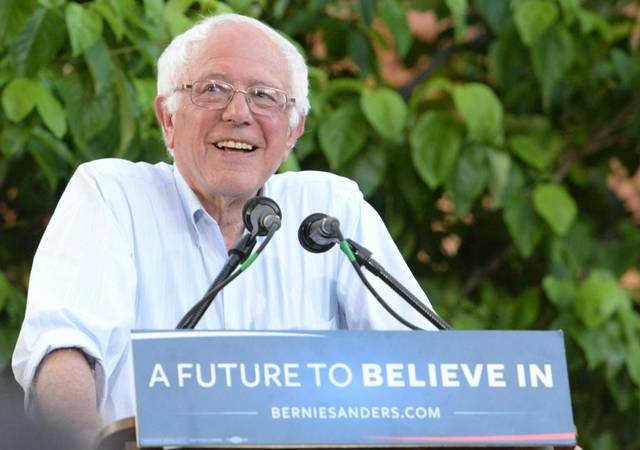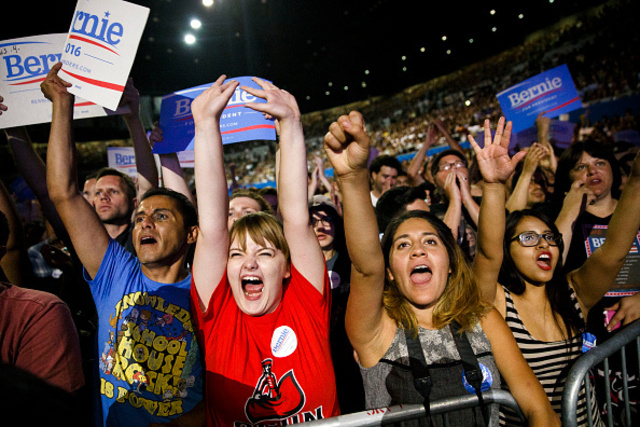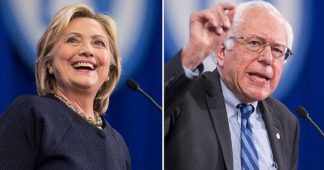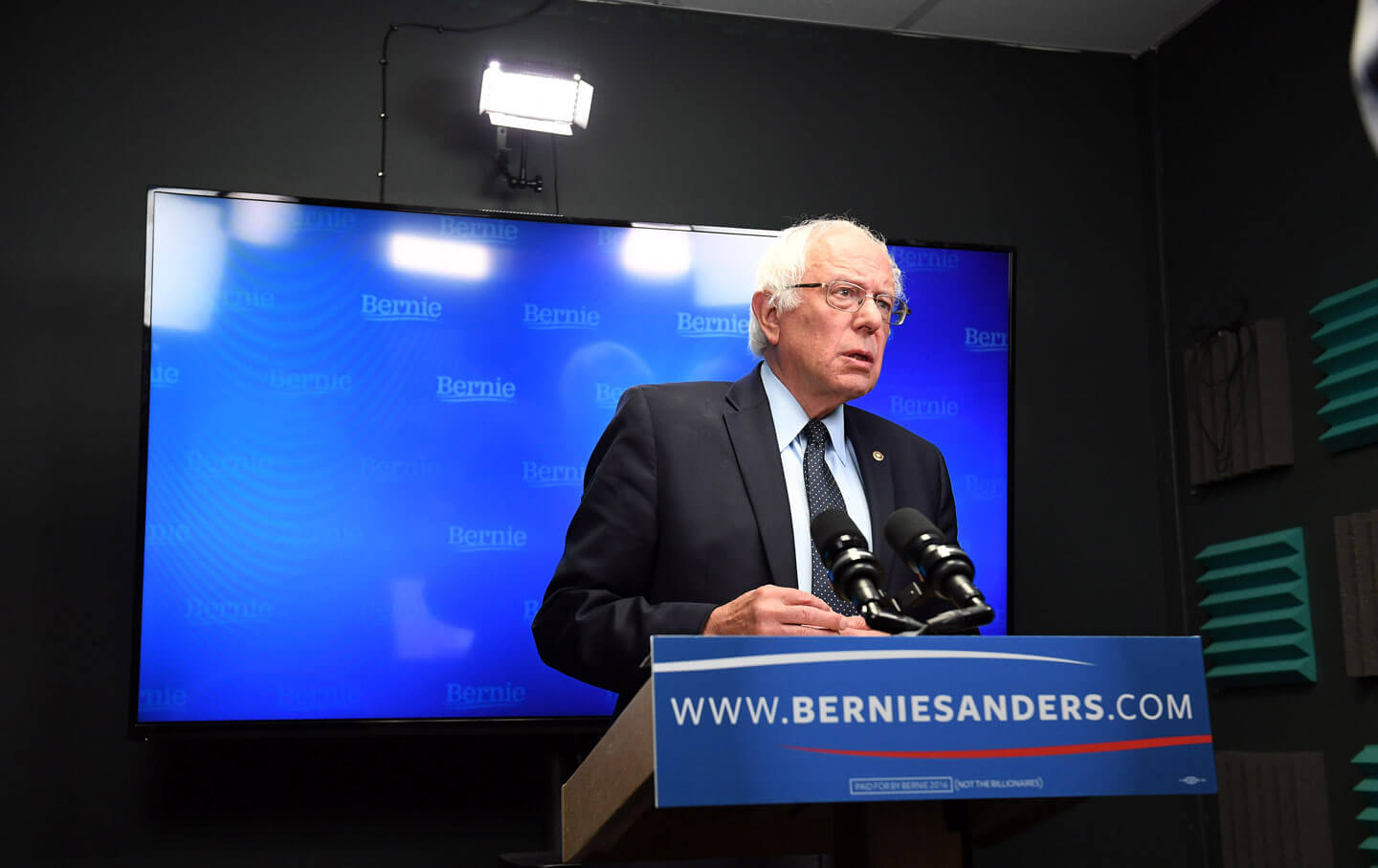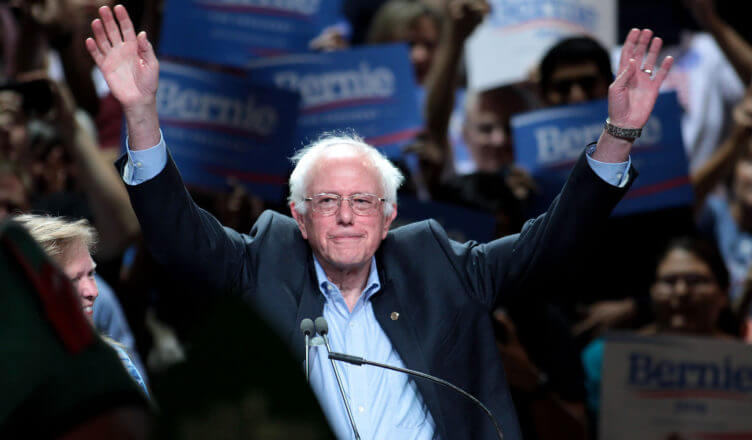by Bob Master
The Bernie Sanders presidential campaign, contrary to all expectation, has become the most important left insurgency in the United States in nearly half a century. A year ago, even his most optimistic supporters might have hoped that Sanders would enliven the presidential debates by challenging Hillary Clinton on issues of Wall Street power and big money corruption, and perhaps garner a quarter to a third of the primary vote. Instead, Sanders won primaries and caucuses in 23 states, and amassed over 12 million votes and nearly 43% of the pledged delegates. And all this while unapologetically and unabashedly proclaiming himself a “democratic socialist,” re-legitimizing a systemic critique of US capitalism for the first time since the one-two punch of Cold War reaction and neoliberal triumphalism froze the left out of mainstream American discourse two generations ago. The power of Big Banks, job-killing trade deals, ending the corrosive influence of big money in elections, eliminating private insurance companies from the health care system, and the merits of a “political revolution” became staples of prime-time presidential debates. Once stunning poll numbers now seem commonplace: 43% of Iowa caucus goers, including roughly a third of Clinton supporters, describing themselves as “socialists”; a New York Times poll late last year which said that 56% of Democratic primary voters had a “positive view of socialism;” and Sanders’ overwhelming support among young voters, by margins as high as 84% in Iowa and New Hampshire, but even reaching the low 60s in states like South Carolina, where he was otherwise crushed. Indeed, Sanders’ remarkable popularity among “millennials” prompted John Della Volpe, the director of a long-running Harvard University poll of young people, to tell the Washington Post that Sanders is “not moving a party to the left. He’s moving…the largest generation in the history of America…to the left.”[1] Something significant is definitely going on.
At this writing, just after the California primary, it appears virtually certain that Hillary Clinton will be the Democratic nominee, and despite her historically high unfavorable ratings, she is likely to defeat Donald Trump in the November election. But the unexpected breadth and fervor of the Sanders movement signifies that the shifts in US political discourse engendered by the financial collapse of 2008 and the Occupy Wall Street movement in 2011 are enduring. Bernie Sanders did not produce this moment—after all, he has been saying literally the exact same things about American society for over 40 years. But as in any movement moment, when the zeitgeist shifts and a leader’s vision gives voice to the hopes of tens of millions of people, the unthinkable suddenly becomes possible.
Despite its enormous promise, the movement has displayed critical limitations. Although Sanders worked hard to enrich his campaign’s analysis and message on issues of concern to people of color, the primacy he gave to questions of class, economic inequality and corporate power evidently prevented many African-Americas and Latinos from seeing themselves in his campaign. This is confounding given that African-Americans were especially hard hit by the ravages of the neoliberal, trickle-down economics Sanders attacks. Black family wealth, already only a fraction of their white counterparts, was halved after Wall Street melted down in 2008, and poor people of color were disproportionately victimized by the predatory loans which fed Wall Street’s speculative bond machine.
But African-American primary voters overwhelmingly supported Hillary Clinton. One leading Pennsylvania African-American faith leader explained to me that many black voters, especially older women, viewed their support for Hillary as upholding a “social contract” that was forged in 2008: after they abandoned Hillary for Obama that year, it was understood that eight years later she would have “her turn.” Younger activists of color, even some who support Sanders, say they didn’t “feel the Bern” because of his initial stumbling response to the challenges of Black Lives Matter protestors. And Michelle Alexander, who eviscerated the Clinton policy legacy in a Nation magazine article entitled “Why Hillary Clinton Doesn’t Deserve the Black Vote,” attributed African-Americans’ 2016 allegiance to the Clintons to a widely held feeling that Bill Clinton was the first President “who actually treated black folks like they were real people, who could be viewed and treated as human beings…who actually would sit down to eat with them and sing in their church and acted like he enjoyed it, who recognized us as human beings.”[2]
Race remains at the core of the American tragedy, and the struggle for Black Lives will not be subsumed in a broader movement. The future potential of a continuing post-Sanders’ radical mobilization for economic justice, racial justice, and democracy will only be realized if it integrates the social critique and constituencies mobilized by BLM and movements for immigrant rights. The support Sanders received from leading black intellectuals, artists and elected officials, like Alexander, Ta-Nehesi Coates, Cornel West, Ben Jealous and Keith Ellison suggest that bridging the gap between the Sanders campaign and the emergent black mobilization is by no means out of the question. Here the labor movement, which despite all its flaws and limitations, remains by far the largest multi-racial institution of working people in our society, could play a crucial role in ensuring that whatever movement building effort that follows the Sanders campaign reflects the increasingly diverse face of American society.
* * *
Today’s labor movement has been largely shaped by its experiences of defeat, on multiple battlefronts over the last 30 years—at the bargaining table, in State Houses, in the courts. In recent years, this prolonged existential crisis has bred some innovation and success, most dramatically in SEIU’s four-year old “Fight for $15 and a Union,” which has sharpened and politicized the discourse about income inequality and stagnant wages that erupted in Occupy Wall Street (not to mention delivering billions of dollars in raises to tens of millions of low-wage workers across the country).
The broad acceptance of $15 an hour as the new standard for the minimum wage – a notion that was ridiculed by many of its current proponents just two years ago—illuminates the critical power of ideas in opening up space for organizing and political and legislative advancement. When fast food workers and their supporters won the ideological battle about what constitutes an adequate minimum subsistence level of compensation, change came with surprising suddenness.
Historian Nelson Lichtenstein has written that “trade unionism requires a compelling set of ideas and institutions, both self-made and governmental, to give labor’s cause power and legitimacy. It is a political project whose success enables the unions to transcend the ethnic and economic divisions always present in the working population.”[3] But labor’s ideological breakthrough in the “Fight for $15” is an exception that proves the rule. By the time the Corporate Right fashioned its relentless and well-planned ideological and practical attack on the labor movement, starting in the mid-70s, decades of complacency and anti-communism had stripped the labor movement of its capacity to respond on an ideological plane. In his famous letter in 1978 resigning from the “Labor—Management Group” after the Business Roundtable-sponsored filibuster buried “Labor Law Reform” in an overwhelmingly Democratic Congress, UAW President Doug Fraser lamented the outbreak of a “one-sided class war” waged by a politically resurgent corporate elite. The unspoken and probably unintended implication was that class war was an alien concept to a labor movement that had come to see itself as the junior, but accepted and well-established, partner in a long term “social compact.”
Missed Opportunities
Thus, it was hardly surprising that when the Sanders campaign’s stunning success confirmed the existence of a mass base of tens of millions of Americans for a new brand of radical, oppositional politics, most of the labor leadership was unmoved. This was the legacy of three generations of labor political pragmatism, even as tens of thousands of rank and file union activists flocked to support the first politician in many years who so clearly articulated a class-based attack on the prevailing order. Sanders’ adherents are a politically diverse and sometimes contradictory group, but at the heart of his campaign lies a deeply felt rage against a political system rigged to serve the interests of Big Banks, Big Carbon and the rest of the corporate elite. This movement is instinctively supportive of the struggles of unions and working people against their employers, as evidenced in the warm welcome Verizon strikers received at Sanders rallies across New York City in the days before the New York primary.
And, as it turns out, language matters, a lot. Before the Sanders campaign, I minimized the significance of candidates or elected officials explicitly describing themselves as socialists. After all, many of the “progressives” on the New York City Council, in the NYS Legislature, and elsewhere across the country, hold views on issues that are virtually indistinguishable from Sanders’ and could be counted on as equally reliable allies and champions. But calling these views as a whole “socialism” makes explicit a critique of capitalism and its shortcomings that cannot be grasped when the word itself is absent. It suggests that the reforms for which we fight are more than just an attempt to ameliorate the ills of a market-driven society; it says that it is the very system which is the problem, and which must be changed. It begs the question of what precisely an alternative system might look like. But the invocation of “socialism” opens the social and political imagination to dreams of real alternatives. Historian Steve Fraser has written that “language, as a philosopher once put it, is the house of being.” Decades of Cold War and neoliberalism rendered the American left homeless, unable to muster the radical hope that Fraser argues was the driving force behind the great reforms of the Progressive Era and New Deal[4]. Bernie Sanders has begun to erect the scaffolding for constructing a new radical imagination.
This ideological reorientation is far more important to the possibility of reviving the labor movement than most labor leaders would acknowledge. Only such a shift offers labor the “compelling set of ideas and institutions, both self-made and governmental, [that could] give labor’s cause power and legitimacy” again. This was the missed opportunity of the 2015-2016 election cycle. As Sanders’ crowds grew across the country, and his forthright critique of trade deals, bank bailouts, and campaign finance corruption attracted millions, most of the labor leadership—ever the conscientious custodians of pragmatism—elected to “go with the frontrunner.” There were a few exceptions of course, including my union, the Communications Workers, as well as the National Nurses union, the Postal Workers, the Amalgamated Transit Union, later the west coast Longshore union and New York’s Nurses Association and Transport Workers Union. And Sanders succeeded beyond anyone’s wildest expectations in shifting the national discourse in the direction of labor’s concerns, despite the lack of support from most of the labor movement. How much more seismic would his campaign have been if even a handful of other major unions had joined the cause, creating greater credibility, providing additional resources, and perhaps helping to establish, most importantly, more organic connections to workers of color.
What’s Next?
The Sanders campaign unleashed a remarkable upsurge of decentralized, largely self-organized, progressive activism. In so doing, it kindled hopes that a post-Sanders movement could lay the foundation for a reinvigorated new left in U.S. politics, both inside and beyond the voting booth. But translating the energy, excitement and activism of a presidential campaign into a new political formation or movement will not be easy. Recent experiences confirm this—from Jesse Jackson’s Rainbow Coalition to Howard Dean’s brief insurgency, to the hopes aroused by the Obama campaign. None of these endeavors actually built an independent, democratically accountable organization that could provide a durable platform for independent issue campaigns or candidacies.
The Sanders phenomenon, however, differs from these predecessors in important ways. For one thing, the radicalism of the candidate’s politics and the historical context of his candidacy—in the aftermath of one of the great global crises of capitalist legitimacy—point towards ongoing mobilization outside normal political channels. Second, the candidate himself has resolutely reinforced the necessity of building such a movement, repeating at rally after rally that the “political revolution”—those words in themselves a remarkable addition to the conventional U.S. electoral lexicon—can only be achieved through the creation of an ongoing movement. Third, the disappointment in Obama, whose campaign felt at times like a movement even if its politics were inchoate, suggests that the mistaken demobilization which followed 2008 may be avoided.
The Sanders campaign has made it possible to imagine building a movement powerful enough to end oligarchical control of our democracy, to avert the planet from climate disaster, to wrest control of the economy from the stranglehold of Wall Street, and to implement the criminal justice reforms and jobs and education programs that will begin to repair the damage inflicted by 400 years of institutionalized racism. What follows are thoughts about questions that should be considered as we enter the next phase of the Sanders movement.
- A new national left party or a single unified organization is unlikely to emerge from the Sanders movement, but let’s build something. The Occupy encampments changed the global political discourse, but the movement’s longer-term potential was squandered by its rejection of organization-building, an anti-leadership obsession with “horizontality,” and an aversion to program. Preoccupation with “holding space” and with decentralized direct action made it impossible to create the Occupy equivalent of SNCC or SDS—an organization that could have carried forward the anti-Wall Street mobilization even after state violence dismantled the encampments. We shouldn’t make those mistakes again.
On the other hand, some optimistic Sanders partisans express a hope that the multiple organizations and individuals which have been galvanized by the campaign can coalesce into a single new progressive organization that unites the left and takes it to a new level. But in an era when institutions from Congress to the labor movement are deeply distrusted, and when the notion of struggling towards ideological unity seems foreign, if not archaic, trying to coalesce the heterogeneous forces backing Sanders into a single organization could prove to be a daunting and possibly counterproductive project. Existing organizations will be reluctant to relinquish identities and infrastructures which have been built up over decades of work.
Our goal should be a new level of coordination on the left, in terms of both issue mobilizations and key electoral races. Sanders or key campaign leaders should convene a new “coordinating committee” comprised of the unions and other organizations which endorsed him: CWA, NNU, ATU, MoveOn, DFA, the Postal Workers and West Coast longshore union, the Working Families Party, Progressive Democrats of America, Democratic Socialists of America, and a host of local unions and local groups. The various self-organized networks which sprang up in support of the campaign—Labor for Bernie, People for Bernie, Millennials for Bernie—would be there. Representatives of unions and social movements, as well as leading independent of-color intellectuals and activists—including those who might not have endorsed Sanders—should be invited. These groups could provisionally unite around a limited number of national campaigns or mobilizations which would build on the progressive political momentum ignited by the Sanders campaign.
- The question of race must be dealt with upfront. In order to gain credibility among constituencies of color which were reluctant to back Sanders, the new formation must unify the agendas of the Occupy, Black Lives and immigration rights movements. It must prominently engage key community and political leaders of color like Representatives Keith Ellison and Raul Grijalva, Ohio State Senator Nina Turner, and NYC Councilmember Jumaane Williams (who led the legislative fight against “stop and frisk”), former NAACP leader Ben Jealous, and intellectuals like Michelle Alexander, who is probably the most significant intellectual influence on millennial activists, both white and black. And from the start, the post-Sanders formation must take up issues that are immediately relevant to constituencies of color—police accountability, stopping the attack on Voting Rights, or comprehensive immigration reform, to suggest just a few examples.
- The new movement should mobilize around a limited agenda that takes on issues of economic and racial exploitation on the one hand, and the reclamation of our democracy on the other. Such an agenda should be clearly understood as an effort to hold the new President and elected Democrats at every level accountable to the yearnings of tens of millions of Americans for racial and economic justice. This issue mobilization must begin—starting at the Democratic National Convention—by uniting forces both inside and outside the Sanders campaign to kill the Trans-Pacific Partnership trade agreement (TPP) once and for all. This is not only the right policy, but critically important for the electoral success of the Democratic Party. So called “free trade” embodies the deep contradiction between the neoliberal bankers and technocrats, on the one side, who have dominated Democratic Party economic policy-making since the Clinton Administration, and its traditional working class base, on the other. It is also now the Party’s most vulnerable Achilles heel with white working class voters, whose sense of betrayal and economic hopelessness drive Trump’s right-wing, nationalistic populism and reduce Clinton’s support among these voters to abysmally low levels. Sanders has already pushed Clinton to rhetorical opposition to the TPP; in the run up to the convention, Sanders and Clinton should work together to extract a promise from Obama that the treaty will not be taken up in the lame duck session.
In 2009, rather than mount mass mobilizations that would have invested Obama’s “hope and change” with real progressive content, labor substituted visits to the White House for street heat. The test of the post-Sanders movement will come in 2017, when it will face the challenge of pushing Clinton to the left and charting a new political agenda for the Democratic Party. It is not hard to imagine a short list of issues around which a new left could organize. A national campaign for a Wall Street Speculation Tax to fund free public higher education or investment in tens of millions of infrastructure jobs would extend the challenge to Wall Street power that lies at the heart of Sanders’ narrative. Communities of color could be galvanized by a national campaign to restore Article 5 of the Voting Rights Act, echoing and broadening Sanders’ demand for a renewed political democracy. And at the local level, let’s mount state-based campaigns for the public financing of elections of District Attorneys—the elected officials who are at the heart of the pitched debate about the unfairness of the criminal justice system. Such a campaign might have huge appeal to grassroots movements like Black Lives Matter. The details of the issue agenda should be vigorously debated, and I claim no monopoly on the correct answer. What is critical is trying to bring together the organizations and constituencies which supported Sanders, along with those who didn’t but also seek a leftward shift in the American political discourse, around a limited set of campaigns that can build on the gains of 2016. By going on the offensive—and thereby defusing a likely Right-Wing counteroffensive to set the terms of debate in 2017—a broad progressive formation can redefine the national agenda around issues of race and class inequity and inaugurate a new era of progressive reform.
- Launch a massive program of grassroots political and economic education. In the waning decades of the 19th century, the Populist movement deployed a small army of “lecturers” who traveled across the Plains talking to farmers about issues of debt, credit, monetary policy and the power of Wall Street over their lives. This popular education helped build the mass base for a reform agenda that ultimately culminated in the sweeping changes of the New Deal. Our movement requires a similar commitment to mass popular education.
In recent years, a number of organizations have experimented with various grassroots popular education programs: Minnesotans for a Fair Economy, various affiliates of People’s Action, and my own union, the Communications Workers of America, are good examples. In the CWA, we have worked with author and activist Les Leopold to develop a participatory curriculum that explains the hyperfinancialization of the neoliberal era, and explores how those developments intersect with institutional racism. Relying on the “small group activity method,” the union has trained 60 rank and file activists—including some from allied groups like NY Citizen Action and Make the Road New York—to lead these workshops. The anti-Wall Street curriculum complements two-day Boot Camps led by the union’s national political department, which aim to develop politically aware activists at the grassroots level across the country. In Minnesota, the vibrant Fair Economy coalition has used popular education techniques to reveal the institutional connections binding together the Twin Cities ruling class. These simple exercises—using networks of string to illustrate these links—can be conducted with literally thousands of activists at a time. This program has helped activists from multiple organizations and struggles to unite in significant challenges to the city’s major power brokers.
One major initiative of any post-Sanders formation should be the convening of groups that are engaged in, or interested in, creating these programs of mass popular education. Curricula and teaching methods can be shared and debated. Funding from unions and foundations for such an effort should be sought. Historically, this kind of education was a function of the parties of the Left. In their absence, other forces will have to assume responsibility.
- An openly socialist current should be built within the new movement.Senator Sanders’ refusal to retreat from his identification with democratic socialism certainly ranks as one of the most remarkable features of the campaign. To those of us who can remember “Commie” as a schoolyard epithet and “duck and cover” air raid drills, let alone labor’s bitter internecine battles over U.S. imperial misadventures in Vietnam and Central America, Sanders’ open embrace of socialism and the absence of “red-baiting” in the campaign has been almost beyond imagination.
The grassroots organization which appears to have experienced the greatest membership growth as a direct result of the Sanders campaign has been the Democratic Socialists of America, which traces its roots to the breakup of the old Socialist Party in the 1950s and is the largest remaining socialist organization in the country. In his account of the decline of American resistance to organized wealth and power in the “second Gilded Age,” The Age of Acquiescence, Steve Fraser argues that “the capacity to envision something generically new, however improbable, has always supplied the intellectual, emotional and political energy that made an advance in civilized life, no matter how truncated, possible.” In this telling, the reforms of the New Deal were driven by the utopian dreams of millions of Americans who believed capitalism must be transcended, and would have been impossible absent the presence of a “multi-faceted and long-lived culture of resistance that was not afraid to venture onto new terrain, to question the given.”[5] In this new moment, while progressive unions and their allies fight for a “21stCentury Glass-Steagall Act,” socialists would demand nationalization of banks. While more mainstream progressives call for a Wall Street Sales Tax, socialists might demand a maximum wage or a wealth tax. More mainstream activists will demand debt-free college education, while socialists would demand free tuition and free mass transit. Whether socialism exists today as a practical alternative form of social organization, or simply as a compelling moral critique of a racialized, financialized capitalism that is leading us to climate disaster, the revival of the idea of socialism facilitates the imagination of radical alternatives to the status quo. For the resuscitation of that hope, we owe an enormous debt of gratitude to Bernie Sanders.
- The “political revolution” must be driven down to the level of school boards, city councils, county legislatures, state government, and Congress. The goal is not to take over the Democratic Party, but to build an infrastructure—an independent political party—comprised of activists and elected officials, both inside and outside the Democratic Party, which can carry the agenda of the Sanders campaign forward. For the last two decades, the Working Families Party, now operating in 11 states, has worked to build the political capacity to challenge corporate, right-wing Democrats, and to help defeat right-wing Republicans in general elections. Operating as a coalition of unions, community organizations and independent progressives, a model which can leverage substantial resources, the Working Families Party has had its greatest success at the state and local level. The Party’s endorsement of Sanders was its first such national endorsement, and created some tension with several of its labor affiliates, most of which had endorsed Clinton. Nevertheless, the WFP’s political and ideological agenda is tightly aligned with that of Sanders; in a sense, Sanders is the national candidate who embodies the Party’s foundational aspirations.
The WFP is not entirely unique. The Maine People’s Alliance, California Calls, Take Action Minnesota, the Richmond, CA Progressive Alliance, similarly pursue an ideologically driven electoral agenda in their respective communities. No one expects the Sanders campaign to morph into the Working Families Party at the state and local level. But the critical races that determine progressive power at the state or local level are fought out far from the glare of the media attention that accompanies a presidential campaign; the euphoria of the 25,000 person rally and the superstar candidate give way to the unglamorous realities of knocking on doors, raising money, and soliciting endorsements. In the long run, something like the Working Families Party, if not new branches of the party itself, will have to be created in localities and states across the country to conduct the hard work of electing progressives, running winning issue campaigns, and then electing more progressives based on that issue success.
Conclusion
Forecasting historical opportunities is a risky business. But taking the long view, it is arguable that the Sanders campaign signifies a critical political crossroads. The 40-year neoliberal ascendancy imploded in the financial meltdown of 2008. An unprecedented level of mass rejection of the political establishment expressed itself in the populist revolts which roiled both major parties in the 2016 primary season. Elites and their policy prescriptions confront a sweeping crisis of legitimacy.
Movements, Frances Fox Piven, has argued, do not move in straight lines. They ebb and flow, sputter and erupt, unpredictably. Five years on, we continue to live in the Occupy moment, and the breadth of Sanders’ appeal reveals that anger at the economic and political status quo seethes like a lava flow across the landscape. Until now, with the notable exceptions of the Fight for $15 and the intense mobilization against the Trans Pacific Partnership trade deal, labor has contributed relatively little to stoking the flames of insurgency. But it is out of precisely such moments that workers’ revolts acquire the force and legitimacy that enable new movements to be built. It is impossible to predict what lies ahead, but a withering labor movement must seize whatever opportunities now present themselves, thanks to Senator Bernie Sanders.
[1] Max Ehrenfreund, Washington Post, “Bernie Sanders is profoundly changing how millennials think about politics,” April 25, 2016.https://www.washingtonpost.com/news/wonk/wp/2016/04/25/bernie-sanders-is-profoundly-changing-how-millennials-think-about-politics-poll-shows/
[2] Michelle Alexander, interviewed on “All in with Chris Hayes,” April 1, 2016,http://www.msnbc.com/all-in/watch/extended-interview-with-michelle-alexander-657082435530.
[3] Nelson Lichtenstein, State of the Union—A Century of American Labor,(Princeton: Princeton University Press, 2002), p. 43.
[4] Steve Fraser, The Age of Acquiescence, (New York: Little, Brown and Company, 2015), p. 201.
[5]Steve Fraser, The Age of Acquiescence, pp. 411, 419.
